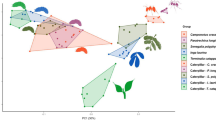Abstract
Caged females of Neacoryphus bicrucis(Hemiptera: Lygaeidae) were permitted to settle upon and oviposit within a small or large ragwort patch, each of which contained both maturing (= adult food/water source) and dehisced (=oviposition substrate/resource for nymphs) flower heads. The proportion of females settling in the large patch was significantly greater than for the small patch but not significantly greater than expected based on the proportion of maturing flower heads contained in each patch. Also, the number of egg masses laid in each patch was proportional to the number of females that settled there. However, egg mass size was significantly skewed toward larger numbers of eggs in the larger patch. Within the large patch egg mass size was significantly larger where the number of dehisced flower heads was greater and accounts for the between-patch difference in number of eggs per mass. Thus, female settlement does not demonstrate a resource concentration effect but females do appear to evaluate patches after settlement with regard to suitability for oviposition.
Similar content being viewed by others
References
Blatchley, W. S. (1926).Heteroptera of Eastern North America, Nature, Indianapolis.
Courtney, S. P. (1983). Models of hostplant location by butterflies: The effect of search images and search efficiency.Oecologia 59: 317–321.
Courtney, S. P. (1985). Apparency in coevolving relationships.Oikos 44: 91–98.
Dethier, V. C. (1959). Food plant distribution and density and larval dispersal as factors affecting insect populations.Can. Entomol. 91: 581–596.
Heisler, I. L. (1987). The evolution of mating preferences and sexually selected traits. In Bradbury, J. W., and Andersson, M. B. (eds.),Sexual Selection: Testing the Alternatives, John Wiley, New York, pp. 96–118.
Janzen, D. H. (1970). Herbivores and the number of tree species in tropical forests.Am. Nat. 104: 501–528.
Jones, R. E. (1977). Movement patterns and egg distribution in cabbage butterflies.J. Anim. Ecol. 46: 195–212.
Kareiva, P. (1982). Experimental and mathematical analyses of herbivore movement: Quantifying the influence of plant spacing and quality on foraging discrimination.Ecol. Monogr. 52: 261–282.
Kareiva, P. (1983). The influence of vegetation texture on herbivore populations: Resource concentration and herbivore movement. In Denno, R. F., and McClure, M. S. (eds.),Variable Plants and Herbivores in Natural and Managed Systems, Academic Press, New York, pp. 259–289.
McLain, D. K. (1981). Resource partitioning by three species of hemipteran herbivores on the basis of host plant density.Oecologia 48: 414–417.
McLain, D. K. (1984). Host plant density and territorial behavior of the seed bug,Neacoryphus bicrucis (Hemiptera: Lygaeidae).Behav. Ecol. Sociobiol. 14: 181–187.
McLain, D. K., and Shure, D. J. (1985). Host plant toxins and unpalatability ofNeacoryphus bicrucis (Hemiptera: Lygaeidae).Ecol. Entomol. 10: 291–298.
McLain, D. K., and Shure, D. J. (1987). Pseudocompetition: Interspecific displacement through misdirected courtship.Oikos 49: 291–296.
McLain, D. K., and Shure, D. J. (1990). Spatial and temporal density dependence of host plant patch use by the ragwort seed bug,Neacoryphus bicrucis (Hemiptera: Lygaeidae).Oikos 58: 306–312.
McLain, D. K., Hancock, M. B., and Hope, M. A. (1990). Fitness effects of nonrandom mating in the ragwort seed bug,Neacoryphus bicrucis (Hemiptera: Lygaeidae).Ethol. Ecol. Evol. 2: 253–262.
Messina, F. J. (1982).Food Plant Selection by Goldenrod Leaf Beetles: Beetle Foraging in Relation to Plant Quality, Ph.D. thesis, Cornell University, Ithaca, NY.
Okubo, A. (1980).Diffusion and Ecological Problems: Mathematical Models, Springer-Verlag, New York.
Parker, G. A. (1985). Phenotype limited evolutionary stable strategies. In Kings College Sociobiology Group (eds.),Current Problems in Sociobiology, Cambridge University Press, Cambridge, pp. 173–201.
Poirier, L. M., and Borden, J. H. (1991). Recognition and avoidance of previously laid egg masses by the oblique-banded leafroller (Lepidoptera: Tortricidae).J. Insect Behav. 4: 501–508.
Price, P. W., Bouton, C. E., Gross, P., McPherson, B. A., Thompson, N. J., and Weis, A. E. (1980). Interaction among three trophic levels: Influence of plants on the interactions between insect herbivores and natural enemies.Annu. Rev. Ecol. Syst. 11: 41–65.
Prokopy, R. J., and Owens, E. D. (1983). Visual detection of plants by herbivorous insects.Annu. Rev. Entomol. 28: 337–364.
Pulliam, H. R., and Curaco, T. (1984). Living in groups: Is there an optimal group size? In Krebs, J. R., and Davies, N. B. (eds.),Behavioural Ecology: An Evolutionary Approach, Sinauer, Sunderland, MA, pp. 122–147.
Ralph, C. P. (1977a). Search behavior of the large milkweed bug,Oncopeltus fasciatus (Hemiptera: Lygaeidae).Ann. Entomol. Soc. Am. 70: 337–342.
Ralph, C. P. (1977b). Effect of host plant density on populations of a specialized seed-sucking bug,Oncopeltus fasciatus.Ecology 58: 799–809.
Rausher, M. (1981). The effect of native vegetation on the susceptibility ofAristolochia reticulata (Aristolochiaceae) to herbivore attack.Ecology 62: 1187–1195.
Root, R. B. (1973). Organization of a plant-arthropod association in simple and diverse habitats: The fauna of collards (Brassica oleracea).Ecol. Monogr. 43: 95–124.
Sauer, D., and Fier, D. (1973). Studies on natural populations ofOncopeltus fasciatus (Dallas), the large milkweed bug.Am. Midl. Nat. 90: 13–37.
Solbreck, C. (1978). Migration, diapause, and direct development as alternative life histories in a bug, Neacoryphus bicrucis. In Dingle, H. (ed.),Evolution of Insect Migration and Diapause, Springer-Verlag, Berlin, pp. 196–217.
Solbreck, C., and Pehrson, I. (1979). Relations between environment, migration and reproduction in a seed bug,Neacoryphus bicrucis (Say) (Hemiptera: Lygaeidae).Oecologia 43: 51–62.
Van Buskirk, J. (1989). Density-dependent cannibalism in larval dragonflies.Ecology 70: 1442–1449.
West-Eberhard, M. J. (1987). Conflicts within and between the sexes in sexual selection. In Bradbury, J. W., and Andersson, M. B. (eds.),Sexual Selection: Testing the Alternatives, John Wiley, New York, pp. 180–198.
Wiklund, C. (1984). Egg-laying patterns in butterflies in relation to their phenology and the visual apparency and abundance of their host plants.Oecologia 63: 23–29.
Wilkinson, L. (1987).Systat: The System for Statistics, Systat Inc., Evanston, IL.
Author information
Authors and Affiliations
Rights and permissions
About this article
Cite this article
McLain, D.K. Oviposition site preference inNeacoryphus bicrucis (Hemiptera: Lygaeidae): Responses to the density and dispersion of a single host-plant species. J Insect Behav 5, 729–739 (1992). https://doi.org/10.1007/BF01047983
Accepted:
Issue Date:
DOI: https://doi.org/10.1007/BF01047983




